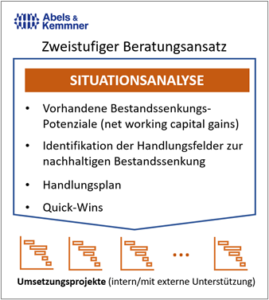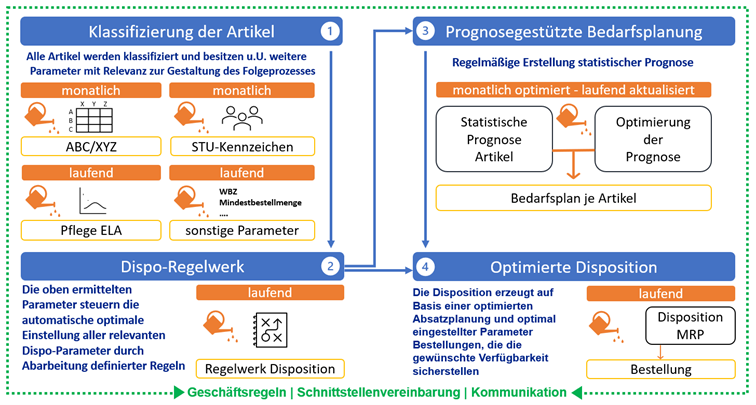By Dr. Bernd Reineke and Fabian Ossen
Creative image formats, brilliant colors and expressive packaging lay the foundation for the marketing of numerous companies. Behind this are suppliers and service providers, including manufacturers of special papers, films and nonwovens. Sihl from Düren is a strong partner for future-oriented industries and creates innovative solutions with high-quality coatings. More than 350 employees in the Sihl Group contribute to the success of its customers from a wide range of industries in almost every country in the world. From automotive to tourism, from packaging and labels to printing and logistics, customers trust the high-quality coatings and technological expertise of the Düren-based company.
The growth and technological progress of the products led Sihl to analyze how to improve the supply chain processes and the decisive competitive advantage of “delivery time”. On the one hand, this was triggered by different, country-specific ERP systems and the associated friction losses.
Another point was the availability of products on the one hand and high stocks of items on the other. And last but not least, customer satisfaction in a highly competitive market in which high delivery readiness and predictability of deliveries are the order of the day.
The goal – transparency, the right levers and motivating quick wins
“We wanted to find the way to the highest possible inventory transparency and master the key starting points for our logistics challenges,” recalls Supply Chain Manager Fabian Ossen. Six specific goals were to be achieved in the project outcome:
- Reliable delivery dates for customers
- Delivery strategies for coordinated delivery times
- Streamlining the value streams
- Reduction in the number of variants
- Review of article parameters with regard to planning and forecasting
- Reduction in net working capital

It was clear to everyone that external support should be brought in for this course to analyze the processes, moderate and develop the measures. It was hoped that quick wins would provide internal motivation to develop far-reaching optimization approaches more quickly and within the set budget.
Logistical optimization using simulation has the edge
The management consultancy Abels & Kemmner was awarded the contract to support and implement this project. The approach of analyzing potential with the aid of a special simulation system was convincing. In addition to the possibility of a digital twin of the ERP system, Abels & Kemmner’s two-stage approach was around 30% cheaper than traditional consulting approaches. It was also hoped that the digital twin would enable rapid data analysis with results that could be implemented quickly.
With the process analysis and the data analysis, the potential analysis is divided into two main areas. All key supply chain processes are scrutinized in the process analysis. During the data analysis, detailed master and transaction data is extracted from the ERP systems and analyzed in the simulation system used in the project. As a rule, obvious potential is uncovered as early as the process recording stage and addressed directly with appropriate measures. The focus was on reviewing stockpiling strategies and classifying materials.
Rapid results and lucrative quick wins
This made it possible to identify excessive stock levels, poor availability or unsuitable items in the product portfolio. With the support of a decoupling point analysis, in which the stock level was determined on the basis of the delivery promise to the customer, incorrect stocking strategies could be uncovered. The simulation system then calculated the necessary inventory levels on the basis of corrected strategies and in turn determined the potential for reducing inventory, i.e. for lower working capital.
Quick wins contributed to a return on investment (ROI) for the consulting project at the beginning of the collaboration. Typical examples of quick wins were uncoordinated processes, particularly in the interfaces between areas of responsibility, or incorrect system settings, such as safety stocks or batch sizes.
Employee involvement promotes acceptance
The results from the process analysis and the data analysis were discussed and verified in potential workshops with the project team and the operational staff and went into the details of processes and data. In the discussion, clear facts provided many details that initially went unmentioned in interviews. In particular, personal notes or additional information that was not contained in the ERP data came to light.
The potential workshops also provided a platform for discussing initial solutions and testing their feasibility. Involving employees directly in the workshop to find solutions helped to achieve a high level of acceptance of the results. With the knowledge they gained, the participants became important multipliers and ambassadors for the promising project ideas.
Result – a robust action plan
After many suggestions and individual measures from the analysis phase, Sihl developed a coordinated action plan. The individual measures were bundled and grouped into priority topics. The project team’s role was to provide support in the design of measures and the assessment of potential. At Sihl, three of the six packages of measures should be emphasized:
“A&K’s simulative analysis of our global value chain showed us the key starting points for improving our delivery readiness and significantly reducing our inventories. The fact that A&K worked with us to implement and achieve the results was a decisive factor for us.”
Fabian Ossen, Supply Chain Manager at Sihl GmbH
Measure 1: Management of the product portfolio
One bitter realization was that a broad (many different products) and deep (large number of variants) product portfolio drives up process and storage costs and erodes margins. Sihl’s existing product portfolio showed the typical signs of an unregulated product development process: while new product ideas were implemented, the company failed to remove old or less profitable products from the range, and the product portfolio management measures are intended to prevent this from happening in future. Market teams were created for this purpose, which regularly analyze the product portfolio, determine start-up and phase-out phases and define successor products. A key factor in the success of this measure was the definition of a regular process that stipulated what had to be done and when, what the basis for decisions had to be and how the decision-making and escalation process was to be carried out.
To this end, suitable methods and analyses were to be determined that would be used regularly, and the necessary tools that would support and simplify the work were to be discussed.
Measure 2: Development of a structured delivery strategy
At the beginning of this measure, a customer survey was carried out at short notice, which yielded the following results:
- More than half of the customers surveyed were dissatisfied with the level of delivery service
- Customers expect shorter delivery times for selected products
As part of this measure, the existing market promises were reviewed and a future delivery strategy for delivery classes was developed.
- The delivery classes provide for different delivery times to the customer. This means that important and high-turnover products can continue to be delivered from stock at short notice.
- Products that are less in demand are re-produced during the replenishment period. The finished and semi-finished products no longer need to be stocked for these delivery classes.
In total, there were 5 different delivery classes.
- Delivery class A: X days
- Delivery class B: X+3 days
- Delivery class C: X+7 days
- Delivery class D: X+21 days
- Delivery class E: on request
This measure alone resulted in a reduction of over 12% in the total value of the portfolio.
Measure 3: Systematization and optimization of scheduling
Up to now, most decisions regarding stockpiling strategies and the associatedplanningparameters have been with the dispatchers. Finally, it was concluded from measure 2 that a system is needed in future that ideally specifies the necessary settings for the scheduling parameters. Key parameters include the planning strategy, the forecast profile, the desired readiness for delivery and the safety stocks as well as the scheduling method and batch size procedure.
Initially were essential material classifications had to be determined:
- ABC classification for economic importance
- XYZ classification for the regularity of consumption
- STU classification for the number of buying customers, etc.
Other material properties can also influence the disposition parameters, such as life cycle (product life cycle), product group, delivery time, product hierarchy, etc.
These properties are incorporated into an MRP set of rules that makes the settings for the materials. In this way, it is precisely specified for each individual material whether a Make to Stock or Make to order strategy is applied and how the numerous parameters (see above) are to be documented. The results of the set of rules therefore have a direct effect on the forecast settings, which also contain the necessary settings for the safety stock calculations.
Finally, the set of rules defines all the parameters required to run the ERP system’s planning run (MRP) in a targeted manner and achieve the calculated potential.
The basis for the systematization and optimization of scheduling is shown in the following illustration:

Successful collaboration continues
A key advantage of the set of rules is the possibility of automation. This is particularly helpful for dispatchers, as they can now recognize the changes in the material properties themselves and do not have to make the settings manually.
The logical consequence of this was a sub-project with Abels & Kemmner, which involved the IT-supported implementation of the regulations. This led to the recommendation to select a suitable, supplementary software system, as programming in the ERP environment was recognized as too complex.
